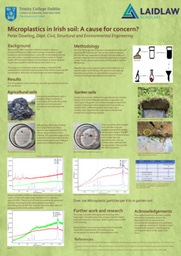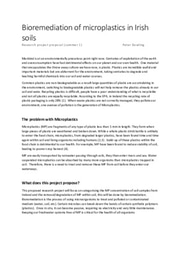Microplastics in Irish soils: Affects and Concentrations
My research project set out to fill in the gap in research surrounding microplastics in soils, particularly in Ireland. Much contemporary research has been conducted around Microplastics (MP) in an aqueous environment, but very little has considered MP in soil, how MP get there and the potential risk they pose. I decided to investigate 5-6 sites in Ireland and determine the soil’s MP concentration.
There is no standard method for extracting MP from soil, Soil is a much more complicated medium than water to analyse so I had to develop several methods, and via trail and error, determine the most effective. In hindsight this stage of the project could have been expedited, the research and trial stage of each method could have been conducted prior to the six-week period. This would have allowed me more time collecting samples and perhaps to broaden my sample size. Six weeks, proved challenging to conduct an environmental survey in.
Nevertheless, after some time I developed a reliable and consistent method for extracting approximately 70%-80% of MP in a soil sample.
The sample sites were in counties Carlow and Dublin, Carlow soils provided agricultural soils while the Dublin soils I used were from gardens. Originally, I wanted this project to entirely focus on agricultural soils and investigate the impact of MP on crops and see if there was any uptake of MP from crops. I was lucky to personally know some farmers from which I could acquire samples, but beyond a few samples I could not gather anymore. Some farmers wouldn’t know the sites history, and others would refuse me entirely. This happened mid-way through my project and was quite disheartening. I had two options, persist with contacting local farms, and hope to gather enough samples within the time remaining, or change my plan and investigate a different environment.
I had to restructure my entire sampling plan and decide a new direction for my project. It was a struggle to know which direction to head in, but with the excellent help from my supervisors I pursued a different avenue of investigation, and I feel the data could be as, if not more interesting.
The data was initially surprising, much lower MP concentration in the agricultural soil than I expected, even given the evidence of plastic on the surface. The equipment used in the analyse throughout my project seemed to have some shortcomings, for example, sometimes it would not detect a MP if it was a very dark colour. This was unexpected and I did not have enough time to consider another analysis method.
Time proved to be my biggest challenge throughout this project. Partly due to the nature of the project, some experiments just took time to conduct, but partly due to my inexperience in planning and organisation. I have learned so much about project planning and how to organise a complicated plan with several task running concurrently. This project showed me the importance of time keeping and planning and I feel I have taken a lot from it.
Even though the direction of this project changed I still deem in a success. I discovered a high concentration of MP in garden soils in several sites in Ireland. This soil is in close proximity to many of us and we are exposed to these MP more than we might realise. One aspect that worried me was the potential risk of exposure of the MP to young children as they play outside.
I found this project challenging but deeply rewarding and interesting. Research and lab work is something I wish to explore more. I am passionate about this topic and cannot wait to conduct more research into this area in the future.



Please sign in
If you are a registered user on Laidlaw Scholars Network, please sign in